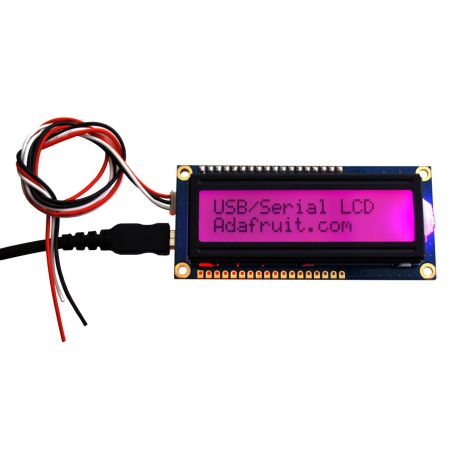16x2 LCD - Positive RGB - USB + Serial
16x2 RGB LCD Display - USB and Serial Interface
Payments are secured by LyraCollect, a French payment collection company.
It is possible to delivered to your home, to a pick-up point or picked up by appointment at MCHobby
We prepare, pack and ship your orders with great respect and care.
A 16x2 RGB LCD that works over USB or Serial line. Great for Linux, Computer or microcontroler projects
It has never been easier to add a character display to your microcontroller projects, your Raspberry-Pi or your PC since Adafruit released its "USB backpack and/or TTL series"! The Backpack is a card specially made by Adafruit, a card that is placed behind a 'standard' LCD display (16x2 or 20x4) and performs all the operations you need such as: display text, scroll automatically, activate and configure the backlight, adjust the contrast, create custom characters, activate or deactivate the cursor, etc. It can even control the RGB backlight with an 8-bit PWM control (enough to create countless backlight colors: red, green, blue, pink, white, purple yellow, bottle green, salmon,... or disable the backlight).
The backpack uses the AT90USB162 component that provides USB and series support for the backpack. The card is waiting for commands on the mini-B USB port or the serial link wires. The USB interface is seen by Windows/Mac/Linux PCs as a COM/serial port. The backpack automatically selects the active USB or serial data source. The connection via USB works at all rates. The TTL serial connection uses the default rate of 9600 but you can send a command to set the rate to 2400, 4800, 9600, 19200, 28800 or 57600 baud.
The flow rate appears on the LCD for one second when power is turned on.
All parameter changes such as the rate, light backlight color, brightness, splash screen, etc are stored permanently in the EEPROM.
The command interface (the commands that can be sent over the serial/USB connection in addition to the text) is compatible with the specifications of the popular "Matrix Orbital" specifications. The backpack will work perfectly with computer applications or libraries designed for a matrix display such as "LCD Smartie" (for example). Adafruit has added some additional commands for the control of the RGB backlight and the definition of the size of the LCD. If you don't want to use these commands, just send ASCII characters to the LCD and what you type will magically appear.
This mini kit consists of 3 mini elements: the Adafruit USB/Serial Backpack, a 16x2 RGB positive LCD display and a row of pinHeader. The LCD must be welded to the backpack using the pinHeader. This operation is quite easy, even for a beginner, but nevertheless requires the use of a soldering iron.
See also the video product discovery (YouTube)
Technical details
Backpack details
- Compatible with all 'standard' 16x2 or 20x4 LCD displays as well as RGB LCDs available at MCHobby.
- Backlight control in PWM
- Support for the following Matrix Orbital commands:
- Auto-scrolling
- Baud rate adjust
- Clear screen
- Change splash screen
- Auto-wrap
- Set cursor
- Home
- Move cursor
- Underline/Block cursor
- Create custom characters
- Save custom character bank
- Load custom character bank
- Display On/Off
- Set brightness
- Set contrast
- General Purpose Outputs (4)
- Adafruit extended command support:
- Set RGB backlight
- Set LCD size (up to 20x4)
LCD details
- 16 characters per line, 2 lines
- Black text on multi-color background
- Support for character sets for English/Japanese text (accents are obtained using custom characters). See the HD44780 data sheet for "character set".
- Create up to 8 characters to make custom glyphs or support foreign languages (such as accented characters).
Tutorial
- See our tutorial on the RGB USB + Serie TTL LCD display in French
Tutorial with example code for Arduino and Python for Raspberry-Pi and Linux - Realize an LCD monitor for Windows/Mac/Linux/Pi (AdaFruit, English)
- Interface : Connector
- USB : Type A, BREAKOUT
- Interface : Bus
- UART
- Interface : Logic
- 5V
- Interface : Vcc (power)
- 5V






